HYDROELECTRICITY
 |
| Share of electricity production from hydropower,2020 |
Hydroelectricity, or hydroelectric power, is electricity produced from hydropower. In 2015, hydropower generated 16.6% of the arena's general strength and 70% of all renewable electricity, and became expected to increase by means of approximately three.1% every 12 months for the next 25 years.
Hydropower is produced in 150 nations, with the Asia-Pacific region producing 33 percentage of global hydropower in 2013. China is the biggest hydroelectricity manufacturer, with 920 TWh of manufacturing in 2013, representing sixteen.Nine% of domestic power use.
 |
| The Three Gorges Dam in Central China is the world's lsrgest power-producing facility of any kind. |
The value of hydroelectricity is surprisingly low, making it a competitive source of renewable electricity. The hydro station consumes no water, in contrast to coal or gas plants. The regular cost of strength from a hydro station larger than 10 megawatts is three to 5 US cents in line with kilowatt hour. With a dam and reservoir it's also a bendy source of energy, on the grounds that the amount produced with the aid of the station may be varied up or down very rapidly (as low as some seconds) to adapt to changing strength demands. Once a hydroelectric complex is constructed, the venture produces no direct waste, and it normally has a considerably decrease output degree of greenhouse gases than photovoltaic power flowers and simply fossil fuel powered electricity flora (see also Life-cycle greenhouse-fuel emissions of energy sources). However, when constructed in lowland rainforest areas, wherein inundation of a part of the forest is important, they are able to emit massive quantities of greenhouse gases.
The construction of a hydroelectric complex can purpose considerable environmental effect, principally in loss of arable land and population displacement. They also disrupt the herbal ecology of the river concerned, affecting habitats and ecosystems, and the siltation and erosion patterns. While dams can ameliorate the risks of flooding, additionally they comprise a chance of dam failure, which may be catastrophic.
History
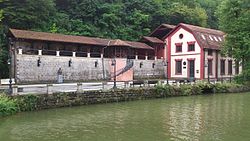 |
| Museum Hydroelectric power plant ″Under the Town″ in Serbia, constructed in 1900 |
Hydropower has been used due to the fact historical times to grind flour and perform other responsibilities. In the past due 18th century hydraulic power supplied the energy source wished for the begin of the Industrial Revolution. In the mid-1770s, French engineer Bernard Forest de Bélidor published Architecture Hydraulique, which described vertical- and horizontal-axis hydraulic machines, and in 1771 Richard Arkwright’s aggregate of water strength, the water body, and continuous manufacturing played a sizable component inside the improvement of the manufacturing unit system, with modern-day employment practices. In the 1840s the hydraulic strength community became advanced to generate and transmit hydro electricity to stop users. By the overdue nineteenth century, the electrical generator became evolved and could now be coupled with hydraulics. The developing call for bobbing up from the Industrial Revolution might power development as nicely. In 1878, the arena's first hydroelectric power scheme turned into evolved at Cragside in Northumberland, England by means of William Armstrong. It turned into used to strength a single arc lamp in his art gallery. The vintage Schoelkopf Power Station No. 1, US, close to Niagara Falls, commenced to produce electricity in 1881. The first Edison hydroelectric strength station, the Vulcan Street Plant, started working September 30, 1882, in Appleton, Wisconsin, with an output of about 12.Five kilowatts. By 1886 there had been 45 hydroelectric strength stations within the United States and Canada; and with the aid of 1889 there have been 2 hundred in the United States by myself.
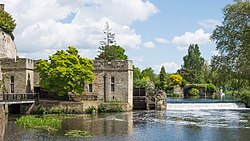 |
| The Warwick Castle water-powered generator house, used for the era of strength for the citadel from 1894 until 1940 |
At the beginning of the 20th century, many small hydroelectric strength stations had been being built by way of industrial corporations in mountains close to metropolitan regions. Grenoble, France held the International Exhibition of Hydropower and Tourism, with over 1,000,000 site visitors. By 1920, when forty% of the strength produced in the United States turned into hydroelectric, the Federal Power Act become enacted into regulation. The Act created the Federal Power Commission to regulate hydroelectric energy stations on federal land and water. As the energy stations became large, their related dams advanced extra functions, which include flood manipulate, irrigation and navigation. Federal funding became essential for large-scale development, and federally owned groups, along with the Tennessee Valley Authority (1933) and the Bonneville Power Administration (1937) have been created. Additionally, the Bureau of Reclamation which had started a sequence of western US irrigation projects inside the early twentieth century, became now building big hydroelectric tasks together with the 1928 Hoover Dam. The United States Army Corps of Engineers changed into also worried in hydroelectric development, finishing the Bonneville Dam in 1937 and being diagnosed through the Flood Control Act of 1936 because the most beneficial federal flood manage enterprise.
Hydroelectric electricity stations persevered to come to be large during the twentieth century. Hydropower was referred to as white coal. Hoover Dam's preliminary 1,345 MW strength station changed into the world's largest hydroelectric energy station in 1936; it turned into eclipsed by using the 6,809 MW Grand Coulee Dam in 1942. The Itaipu Dam opened in 1984 in South America as the largest, generating 14 GW, however turned into surpassed in 2008 by using the Three Gorges Dam in China at 22.5 GW. Hydroelectricity might in the end supply some international locations, inclusive of Norway, Democratic Republic of the Congo, Paraguay and Brazil, with over eighty five% in their strength. The United States currently has over 2,000 hydroelectric power stations that supply 6.4% of its overall electric production output, that's 49% of its renewable electricity.
Future potential
The technical capacity for hydropower development around the world is a whole lot extra than the real manufacturing: the percent of potential hydropower potential that has not been developed is seventy one% in Europe, seventy five% in North America, 79% in South America, ninety five% in Africa, 95% in the Middle East, and 82% in Asia-Pacific. Due to the political realities of recent reservoirs in western international locations, monetary barriers in the 1/3 world and the shortage of a transmission system in undeveloped areas, perhaps 25% of the ultimate technically exploitable potential can be evolved earlier than 2050, with the bulk of that being within the Asia-Pacific location. Some nations have notably evolved their hydropower ability and have little or no room for increase: Switzerland produces 88% of its ability and Mexico eighty%.
Generating methods
Conventional ( dams )
Most hydroelectric power comes from the potential energy of dammed water driving a water turbine and generator. The power extracted from the water relies upon at the quantity and at the difference in peak between the supply and the water's outflow. This top difference is called the pinnacle. A large pipe (the "penstock") offers water from the reservoir to the turbine.
Pumped-storage
This approach produces energy to supply excessive peak needs by means of transferring water among reservoirs at distinct elevations. At times of low electric call for, the excess technology capability is used to pump water into the higher reservoir. When the demand will become extra, water is launched again into the lower reservoir through a turbine. Pumped-garage schemes currently provide the most commercially crucial means of massive-scale grid power storage and enhance the each day capacity factor of the era device. Pumped storage is not an power source, and looks as a bad variety in listings.
Run-of-the-river
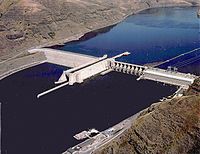 |
| Run-of-the-river |
Run-of-the-river hydroelectric stations are those with small or no reservoir ability, in order that best the water coming from upstream is to be had for technology at that moment, and any oversupply should pass unused. A steady supply of water from a lake or existing reservoir upstream is a sizeable benefit in choosing web sites for run-of-the-river. In the US, run of the river hydropower may want to doubtlessly offer 60,000 megawatts (eighty,000,000 hp) (approximately thirteen.7% of overall use in 2011 if continuously to be had).
Tide
 |
| Tidal |
A tidal power station uses the each day rise and fall of ocean water due to tides; such sources are pretty predictable, and if conditions permit construction of reservoirs, also can be dispatchable to generate electricity at some stage in high demand durations. Less common kinds of hydro schemes use water's kinetic energy or undammed resources including under
shot water wheels. Tidal energy is possible in a enormously small quantity of locations around the arena. In Great Britain, there are eight sites that would be advanced, that have the potential to generate 20% of the energy used in 2012.
Sizes , Types and capacities of hydroelectric facilities
Large facilities
Large-scale hydroelectric strength stations are more typically visible as the biggest strength generating facilities inside the international, with a few hydroelectric centers able to producing extra than double the installed capacities of the current largest nuclear electricity stations.
Although no authentic definition exists for the ability range of huge hydroelectric electricity stations, centers from over some hundred megawatts are usually considered big hydroelectric facilities.
Currently , only 4 facilities over 10 GW ( 10,000 MW ) are in operation worldwide.
Small
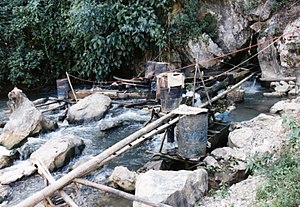 |
| A micro-hydro facility in Vietnam |
Small hydro is the development of hydroelectric power on a scale serving a small network or commercial plant. The definition of a small hydro undertaking varies however a generating potential of up to ten megawatts (MW) is normally usual because the higher limit of what may be termed small hydro. This can be stretched to twenty-five MW and 30 MW in Canada and the US. Small-scale hydroelectricity manufacturing grew by means of 29% from 2005 to 2008, elevating the full world small-hydro ability to 85 GW. Over 70% of this turned into in China (sixty five GW), followed by Japan (3.Five GW), america (3 GW), and India (2 GW).
Small hydro stations may be linked to traditional electrical distribution networks as a supply of low-cost renewable power. Alternatively, small hydro projects can be constructed in isolated areas that could be uneconomic to serve from a network, or in regions wherein there may be no national electric distribution community. Since small hydro initiatives usually have minimal reservoirs and civil production paintings, they are visible as having a relatively low environmental effect as compared to big hydro. This decreased environmental impact depends strongly at the balance between stream float and electricity production.
Micro
Micro hydro is a term used for hydroelectric power installations that generally produce up to a hundred kW of energy. These installations can provide electricity to an remoted home or small network, or are every so often connected to electric powered power networks. There are many of these installations around the world, specifically in developing countries as they can offer a cost-effective source of energy without buy of gasoline. Micro hydro systems complement photovoltaic solar energy systems due to the fact in many areas, water waft, and as a result available hydro power, is highest within the wintry weather whilst sun electricity is at a minimal.
Pico
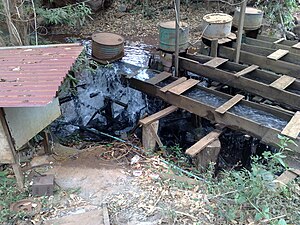 |
| Pico hydroelectricity in Mondulkiri , Cambodia |
Pico hydro is a term used for hydroelectric strength technology of below 5 kW. It is beneficial in small, remote communities that require handiest a small quantity of energy. For example, the 1.1 kW ITDG Pico Hydro Project in Kenya elements 57 houses with very small electric powered masses (e.G., a couple of lighting and a phone changer, or a small TV/radio). Even smaller generators of two hundred-three hundred W can also power a few homes in a developing u . S . A . With a drop of simplest 1 m (three toes). A Pico-hydro setup is normally run-of-the-river, which means that dams are not used, but instead pipes divert some of the go with the flow, drop this down a gradient, and via the turbine before returning it to the circulation.
Underground
An underground power station is normally used at large facilities and makes use of a huge herbal height distinction between two waterways, including a waterfall or mountain lake. A tunnel is built to take water from the excessive reservoir to the producing hall constructed in a cavern near the lowest point of the water tunnel and a horizontal tailrace taking water away to the lower outlet waterway.
Properties
Advantages
Flixibility
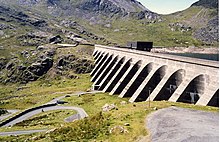 |
| The Ffestiniog Power Station can generate 360 MW of electricity inside 60 seconds of the demand arising. |
Hydropower is a versatile source of energy on account that stations may be ramped up and down very quickly to adapt to changing strength needs. Hydro mills have a start-up time of the order of a few minutes. It takes around 60 to 90 seconds to bring a unit from bloodless begin-up to complete load; that is lots shorter than for fuel turbines or steam plant life. Power era also can be decreased speedy while there's a surplus energy technology. Hence the confined ability of hydropower gadgets is not normally used to produce base electricity except for vacating the flood pool or assembly downstream needs. Instead, it is able to serve as backup for non-hydro mills.
Low cost/high value power
The main benefit of conventional hydroelectric dams with reservoirs is their capability to save water at low price for dispatch later as high price smooth strength. The common cost of strength from a hydro station larger than 10 megawatts is 3 to 5 US cents in keeping with kilowatt-hour. When used as height strength to satisfy demand, hydroelectricity has a higher cost than base energy and a far higher price in comparison to intermittent electricity resources.
Hydroelectric stations have long monetary lives, with a few flowers nevertheless in service after 50–a hundred years. Operating hard work value is also commonly low, as plants are automated and feature few personnel on website at some point of ordinary operation.
Where a dam serves multiple functions, a hydroelectric station can be brought with pretty low production cost, providing a useful sales circulate to offset the prices of dam operation. It has been calculated that the sale of strength from the Three Gorges Dam will cover the development fees after five to eight years of complete generation. However, a few records shows that in maximum countries massive hydropower dams can be too costly and take too lengthy to build to supply a positive risk adjusted go back, unless suitable chance management measures are installed location.
Suitabilitiy for industrial applications
While many hydroelectric tasks supply public strength networks, some are created to serve unique industrial establishments. Dedicated hydroelectric projects are regularly built to provide the sizeable quantities of strength wanted for aluminium electrolytic vegetation, as an instance. The Grand Coulee Dam switched to guide Alcoa aluminium in Bellingham, Washington, United States for American World War II airplanes before it was allowed to provide irrigation and power to residents (further to aluminium energy) after the battle. In Suriname, the Brokopondo Reservoir changed into constructed to provide energy for the Alcoa aluminium industry. New Zealand's Manapouri Power Station become built to supply power to the aluminium smelter at Tiwai Point .
Reduced carbon dioxide emissions
Since hydroelectric dams do now not use fuel, power era does no longer produce carbon dioxide. While carbon dioxide is to start with produced at some stage in production of the challenge, and a few methane is given off yearly through reservoirs, hydro has one of the lowest lifecycle greenhouse gas emissions for power era. Compared to fossil fuels producing an equal quantity of energy, hydro displaced 3 billion tonnes of CO2 emissions in 2011. According to a comparative have a look at via the Paul Scherrer Institute and the University of Stuttgart, hydroelectricity in Europe produces the least quantity of greenhouse gases and externality of any energy supply. Coming in 2nd location was wind, 0.33 changed into nuclear power, and fourth turned into sun photovoltaic. The low greenhouse gas effect of hydroelectricity is determined specially in temperate climates. Greater greenhouse gasoline emission impacts are discovered inside the tropical regions due to the fact the reservoirs of electricity stations in tropical areas produce a larger quantity of methane than those in temperate regions.
Like different non-fossil gasoline assets, hydropower additionally has no emissions of sulfur dioxide, nitrogen oxides, or different particulates.
Other uses of the reservoir
Reservoirs created by way of hydroelectric schemes regularly provide centers for water sports, and turn out to be vacationer attractions themselves. In a few countries, aquaculture in reservoirs is commonplace. Multi-use dams set up for irrigation help agriculture with a distinctly consistent water deliver. Large hydro dams can control floods, which would in any other case have an effect on people dwelling downstream of the task.
Disadvantages
Ecosystem damage and loss of land
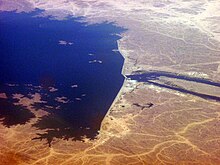 |
| Merowe Dam in Sudan. Hydroelectric strength stations that use dams submerge big areas of land because of the requirement of a reservoir. These modifications to land colour or albedo, along certain projects that simultaneously submerge rainforests, can in these unique cases bring about the global warming impact, or equal life-cycle greenhouse gases of hydroelectricity initiatives, to probably exceed that of coal electricity stations. |
Large reservoirs associated with traditional hydroelectric power stations result in submersion of full-size regions upstream of the dams, occasionally destroying biologically rich and efficient lowland and riverine valley forests, marshland and grasslands. Damming interrupts the go with the flow of rivers and may damage nearby ecosystems, and building massive dams and reservoirs regularly entails displacing humans and flora and fauna. The loss of land is often exacerbated with the aid of habitat fragmentation of surrounding areas due to the reservoir.
Hydroelectric tasks can be disruptive to surrounding aquatic ecosystems each upstream and downstream of the plant web site. Generation of hydroelectric energy adjustments the downstream river surroundings. Water exiting a turbine typically includes very little suspended sediment, that could lead to scouring of river beds and lack of riverbanks. Since turbine gates are frequently opened intermittently, rapid or maybe day by day fluctuations in river go with the flow are observed.
Water loss by evaporation
A 2011 have a look at by the National Renewable Energy Laboratory concluded that hydroelectric vegetation in the United States fed on between 5.39 to sixty eight.14 cubic metres consistent with megawatt-hour (1,425 to 18,000 US gallons in line with megawatt-hour) of energy generated, thru evaporation losses within the reservoir. The median loss became 17.00 m3/MWh (4,491 US gal/MWh), that is better than the loss for generation technology that use cooling towers, inclusive of concentrating solar power at three.27 m3/MWh (865 US gal/MWh) for CSP trough and 2.Ninety eight m3/MWh (786 US gal/MWh) for CSP tower, coal at 2.60 m3/MWh (687 US gal/MWh), nuclear at 2.54 m3/MWh (672 US gal/MWh), and natural fuel at zero.75 m3/MWh (198 US gal/MWh). Where there are a couple of makes use of of reservoirs including water supply, undertaking, and flood control, all reservoir evaporation is attributed to energy production.
Siltation and flow shortage
When water flows it has the ability to move particles heavier than itself downstream. This has a bad effect on dams and ultimately their electricity stations, especially those on rivers or within catchment areas with high siltation. Siltation can fill a reservoir and decrease its ability to govern floods along with causing extra horizontal strain on the upstream portion of the dam. Eventually, some reservoirs can end up complete of sediment and vain or over-pinnacle at some stage in a flood and fail.
Changes in the amount of river waft will correlate with the quantity of energy produced with the aid of a dam. Lower river flows will lessen the amount of live garage in a reservoir consequently lowering the amount of water that can be used for hydroelectricity. The end result of faded river float can be power shortages in areas that rely closely on hydroelectric energy. The threat of drift scarcity can also boom due to weather alternate. One study from the Colorado River within the United States endorse that modest weather modifications, inclusive of an boom in temperature in 2 diploma Celsius resulting in a ten% decline in precipitation, may lessen river run-off by using as much as forty%. Brazil mainly is inclined because of its heavy reliance on hydroelectricity, as increasing temperatures, decrease water waft and changes in the rainfall regime, could reduce overall strength manufacturing by means of 7% yearly via the give up of the century.
Methane emission ( From reservoirs )
Lower high-quality influences are found within the tropical regions. In lowland rainforest regions, where inundation of a part of the woodland is vital, it's been cited that the reservoirs of electricity plant life produce significant quantities of methane. This is due to plant material in flooded areas decaying in an anaerobic environment and forming methane, a greenhouse gas. According to the World Commission on Dams document, in which the reservoir is big in comparison to the producing ability (much less than 100 watts consistent with square metre of surface vicinity) and no clearing of the forests inside the region changed into undertaken prior to impoundment of the reservoir, greenhouse gasoline emissions vfrom the reservoir can be better than the ones of a conventional oil-fired thermal era plant.
In boreal reservoirs of Canada and Northern Europe, but, greenhouse gas emissions are commonly simplest 2% to eight% of any kind of traditional fossil-gas thermal technology. A new class of underwater logging operation that goals drowned forests can mitigate the impact of wooded area decay.
Relocation
Another drawback of hydroelectric dams is the want to relocate the human beings residing wherein the reservoirs are planned. In 2000, the World Commission on Dams predicted that dams had bodily displaced 40-eighty million human beings global.
World hydroelectric capacity
 |
| World renewable energy share ( 2008 ) |
The ranking of hydroelectric ability is both through actual annual energy manufacturing or with the aid of installed ability power score. In 2015 hydropower generated 16.6% of the worlds overall power and 70% of all renewable power. Hydropower is produced in 150 international locations, with the Asia-Pacific area generated 32 percent of global hydropower in 2010. China is the most important hydroelectricity producer, with 721 terawatt-hours of manufacturing in 2010, representing around 17 percentage of domestic electricity use. Brazil, Canada, New Zealand, Norway, Paraguay, Austria, Switzerland, Venezuela, and numerous other international locations have a majority of the internal electric electricity manufacturing from hydroelectric electricity. Paraguay produces 100% of its strength from hydroelectric dams and exports 90% of its manufacturing to Brazil and to Argentina. Norway produces ninety six% of its energy from hydroelectric resources.
A hydroelectric station hardly ever operates at its full strength score over a full year; the ratio between annual average electricity and set up capacity score is the capacity factor. The installed ability is the sum of all generator nameplate energy rankings.
WRITTEN BY : ADRISH WAHEED
Labels: HYDROELECTRICITY


0 Comments:
Post a Comment
Subscribe to Post Comments [Atom]
<< Home